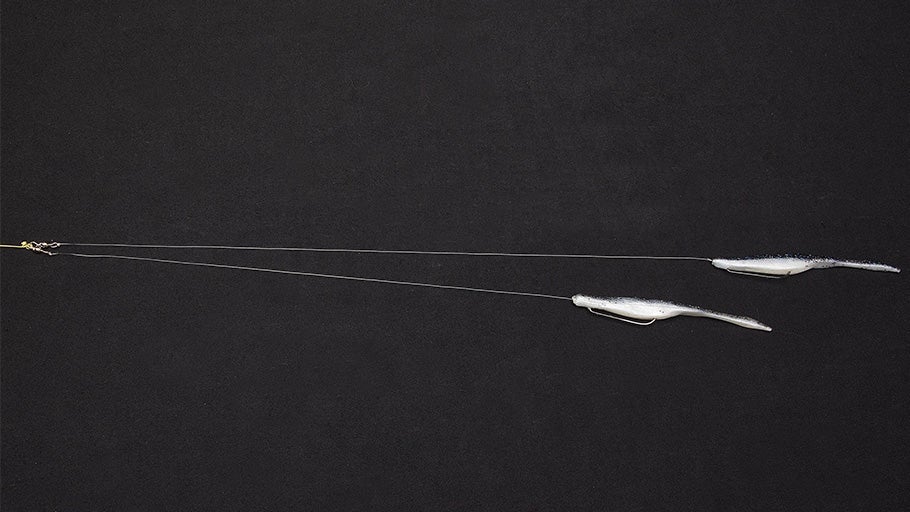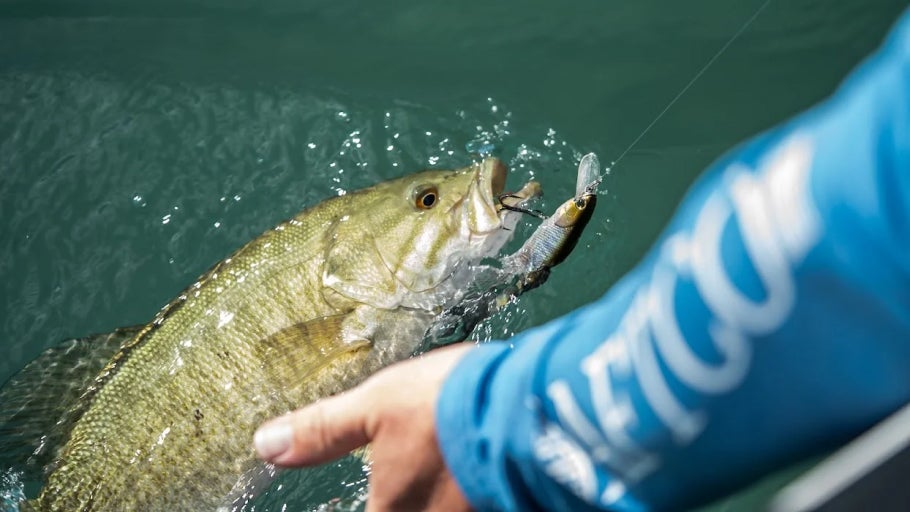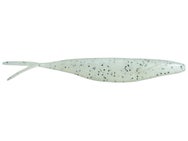
Soft Plastic Jerkbait Gear Guide
A mainstay of serious bass anglers for decades, soft plastic jerkbaits feature an iconic baitfish shape that provides versatility for anglers who want to catch both size and quantity. Commonly referred to as a “Fluke,” these relatively simple soft plastics create an enticing injured baitfish imitation that’s become exceedingly popular for use with forward-facing sonar or anglers who need to search shallow water with excellent efficiency. In this gear guide, we delve into the world of soft plastic jerkbaits, explore effective rigging methods, and identify all the essential gear you’ll need to unlock their full fish-catching potential.
Rods for Soft-Plastic Jerkbaits
Soft plastic jerkbaits are often rigged weightless, so the ideal rod needs to have a soft enough tip section to effectively fling a lightweight presentation, while still providing enough backbone to drive an extra wide gap hook home for a solid hookset. Luckily, most light-duty jig and worm rods also excel with soft plastic jerkbaits, so there's a good chance you already own a rod that will work. When fishing a traditional Texas-rigged soft plastic jerkbait, a medium-heavy power rod with a fast-to-extra fast taper will get the job done. For rod length, most anglers typically prefer a slightly shorter length between 7’ to 7’4” for improved handling when working the bait
Reels for Soft-Plastic Jerkbaits
In most scenarios, you’ll want to reach for a size 70 to 150 baitcasting reel with a slightly faster 7.0:1 gear ratio or higher so you can quickly pick up line when twitching the bait or catch up to a bite that knocked slack into your line. These smaller and more compact reels are better equipped to handle light baits without hindering casting distance or accuracy and allow your hand to rest comfortably on the reel while you’re working the bait. A faster gear ratio gives anglers more time to drive the hook home but also makes it easy to overwork the bait, so always be mindful of your cadence and try to adjust based on how the fish are reacting. If you’re going finesse with a small soft plastic Fluke it can be advantageous to switch over to spinning tackle, in which case any 2500–3000 size spinning reel is a good choice.
Line for Soft-Plastic Jerkbaits
Most anglers rely on the stealthy attributes of a 10–17lb fluorocarbon line for its ability to remain nearly invisible underwater and help the Fluke sink beneath the surface to enhance the action and its natural appeal. Fluorocarbon provides excellent abrasion resistance so you can confidently fish around wood, light cover, and vegetation without worrying about damaging your line. If you’re fishing the soft plastic jerkbait on a spinning combo, a braided mainline in conjunction with your favorite fluorocarbon leader provides the perfect combination of castability, strength, and sensitivity.
Modifications & Rigging for Soft-Plastic Jerkbaits
Whether you are dealing with heavy cover, finicky fish, or short strikes, you can bet there’s a way to rig a Fluke that will remedy the issue. Most of the time, when anglers are talking about fishing a “Fluke” they are referring to a Texas-rigged soft plastic jerkbait, but because of its fishy shape and action they can be paired with a wide range of techniques to fool bass, like vibrating jigs, Carolina-rigs, and minnow jigheads. For simplicity sake, we’ll focus this section on rigging techniques that rely on the gliding action of the bait in conjunction with input from the angler.
Texas-Rigged
This rigging is incredibly weedless, and especially effective around roaming baitfish and anytime bass are shallow. There are a couple of different hook types that you can use to Tex-pose a soft plastic jerkbait, including EWG swimbait hooks and offset round bend worm hooks. The weight of your hook can greatly affect the rate at which your bait sinks, so it can pay off to play around with different hook/bait combinations when you want a faster/slower rate of fall.
Nose Hook With Screw Lock
Arguably one of the easiest ways to fish a Fluke, the advantage of this rigging is the increased hookup ratio. With a single, exposed hook point you no longer have to worry about driving a heavy gauge hook through the lip. However, this rigging also opens the door to snagging, so it is best utilized in open water scenarios.
Line-Through Treble Took
If one hook point is good, three must be better. This sneaky rigging makes it easy to get a hook in fish, but it requires a little bit of prep work, and hangs up easily, so it’s best to rig a bunch ahead of your fishing trip and utilize it when cover isn’t an issue.
Double Fluke
If you thought fishing a single Fluke was fun, you are going to have a blast fishing the double Fluke, or “donkey rig.” Watch your baits dance back and forth, while waiting for ol’ big to come grab a bite. This technique also offers the opportunity to catch two fish at once, making it a great choice when the bite is red hot.
Tips & Tricks for Soft-Plastic Jerkbaits
Most soft-plastic jerkbaits fall very slowly, which can be ideal in a lot of scenarios, but when you want to fish slightly deeper or fish are reacting to a quick falling bait, it can be advantageous to add a little bit of weight. There are several sneaky ways to add weight to your bait without overpowering the action of your bait.
Hook selection is a great way to add some weight to your Fluke with minimal effort. A thick gauge hook like the Gamakatsu Superline or a weighted EWG swimbait hook with a light weight along the shank makes it easy to get your bait down quickly. Wrapping lead wire or suspend strips around the shank of your hook will also achieve the same effect. You can also add weight directly to the bait by burying a couple of nail weights into the belly of your soft plastic jerkbait. Adding a large crane swivel 12” to 18” above your bait will also provide some heft to your presentation. For added attraction, use a bright chrome or silver swivel to create the illusion your bait is chasing down a small fish itself.
Best Colors for Soft-Plastic Jerkbaits
The size, shape, and action of the soft-plastic jerkbaits make them one of the best baits for imitating baitfish, so start with baitfish-inspired colors that match-the-hatch and adjust to transparent or darker variations based on the water clarity. If you happen to spot small forage like bluegill or small crappie, start cycling through darker colors, like green pumpkin and junebug. When the fish are feeding heavily on baitfish during the pre-spawn and spawn months, experiment with bright colors like bubblegum or chartreuse to present an enticing alternative or agitate territorial bed fish.
Parting Thoughts on Soft-Plastic Jerkbaits
The Fluke’s inherent baitfish profile and naturalized action make it a bass-catcher straight out of the package. However, practicing different cadences and experimenting with modifications and rigging can unlock its full potential. Whether you’re targeting aggressive bass in shallow waters or enticing suspended fish with forward-facing sonar, the versatility and adaptability of soft plastic jerkbaits is second-to-none. An indispensable tool for most anglers, soft plastic jerkbaits have been proven effective for decades and still being adapted for new techniques.
Related Content Links






































































